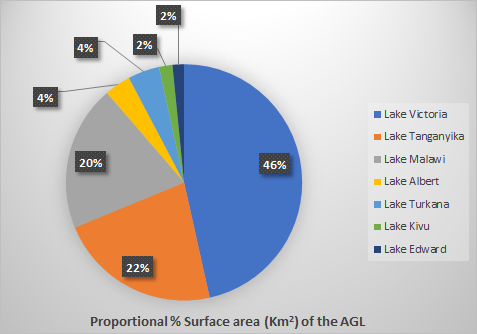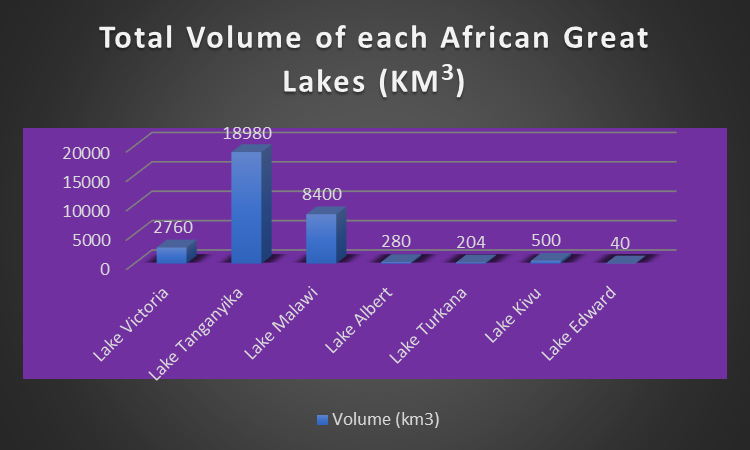Lakes Turkana, Victoria, Tanganyika, Kivu, Edward, Malawi and Albert, all found within the tropics, are collectively referred to as The African Great Lakes. The lakes are shared by 10 countries, namely Ethiopia, Uganda, Tanzania, Ethiopia, Rwanda, Kenya, Burundi, Zambia, Malawi, Democratic Republic of Congo DRC and Mozambique. The African Great Lakes which are all part of the rift valley lakes are endowed with plethora of uniqueness. Cumulatively, the lakes command approximately 25% of the total global unfrozen freshwaters and covers a total surface area of about 138,447km2. This article highlights the facts about the Great Lakes in Africa.
Lake Victoria, shared by Kenya, Tanzania and Uganda, acts as a reservoir for at least four hydropower stations along the Nile River. Globally, the lake is the second largest freshwater after Lake Superior in North America and the largest lake in Africa. The lake occupies a surface area of 68800 km2, a volume of 2760 km3 and a shoreline of 3440km.
Lake Tanganyika, world’s longest lake, and the deepest lake in Africa, borders Tanzania, Burundi, Zambia and Democratic Republic of Congo, covers an estimated surface area of 32600 km2, a volume of 18980 km3 and a shoreline of 1828 km. Lake Tanganyika is also the largest lake among the Albertine Rift lakes. Other Albertine Rift lakes include Lake Edward, Lake Kivu and Lake Albert.
Lake Turkana, shared by Kenya and Ethiopia is the largest permanent desert lake. The lake, though alkaline and shallow whose depth varies between 30 m in some places with other places being as deep as 109 m. Lake Turkana occupies a surface of about 6405 km2 with an 820 km shoreline.
Lake Edward is the smallest African Great Lake and is shared by Democratic Republic of Congo DRC and Uganda occupying a surface area of 2325 km2, a volume of 40 km3 and a shoreline of 290 km.
Lake Malawi/ Niassa/ Nyasa shared by Tanzania, Malawi and Mozambique, has an average depth of 264 m and a maximum depth of 700m making it the third deepest freshwater lake globally and the ninth largest freshwater lake on Earth. The lake occupies a surface area at 29,500 km2 and a volume of 8400 km3.
Lake Kivu is shared between Democratic Republic of Congo DRC and Rwanda with a shoreline of 860 km, a volume of 500 km3 and a surface area of about 2370 km2 making it the second smallest African Great lakes and situated at the highest altitude. It is the third deepest among the African Great Lakes and the only lake with high amounts of Carbon (IV) oxide and methane among those lakes.
Lake Albert is shared by Democratic Republic of Congo DRC and Uganda. This lake occupies a surface area is 5300 km2, a volume of 280km3 and a shoreline of 508 km.
Various rivers provide interlinkages between the great lakes. For example, Lake Kivu connects to Lake Tanganyika through Rusizi River while River Nile flows from Lake Victoria to Lake Albert through Lake Kyoga situated in central Uganda and then flows out as White Nile towards South Sudan finally emptying her waters into the Mediterranean Sea. Semliki River links Lake Edward with Lake Albert. Lukuga River flows from Lake Tanganyika into the Congo River which snakes into the Atlantic Ocean. The Shire River empties Lake Malawi into the Zambezi River which discharges its water into the Indian Ocean. All African Great Lakes are transboundary resources and hence nations in this region are encouraged to collectively come up with similar legal mechanisms to govern these treasured gems for posterity. Below are the graphical representation of the surface area and volumes occupied by the African Great Lakes proportional to the total surface area and volume of the entire African Great Lakes surface area and volume.

